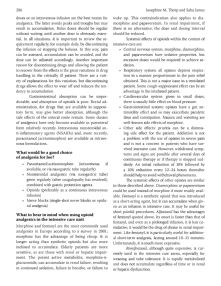Page 298 Guide to Pain Management in Low-Resource Settings
P. 298
286 Josephine M. Th orp and Sabu James
doses or an intravenous infusion are the best routes for wake up. This contraindication also applies to dia-
analgesics. Th e latter avoids peaks and troughs but may morphine and papaveretum. In renal impairment, if
result in accumulation. Bolus doses should be regular there is no alternative, the dose and dosing interval
without waiting until another dose is obviously essen- should be reduced.
tial. In all situations, it is important to review the re- Systemic eff ects of opioids within the context of
quirement regularly, for example daily, by discontinuing intensive care are:
the infusion or stopping the boluses. In this way, pain • Central nervous system: morphine, diamorphine,
can be assessed, accumulation can be avoided, and the and papaveretum have sedative properties, but
dose can be adjusted accordingly. Another important excessive doses would be required to achieve se-
reason for discontinuing drugs and allowing the patient dation.
to recover from the eff ects is the great variations in drug • Respiratory system: all opiates depress respira-
handling in the critically ill patient. Th ere are a vari- tion in a manner proportionate to the pain relief
ety of explanations for this variation, but discontinuing obtained. Th is is not a major issue in a ventilated
drugs allows the eff ect to wear off and reduces the ten- patient. Some cough-suppressant eff ect can be an
dency to accumulation. advantage in the intubated patient.
Gastrointestinal absorption can be unpre- • Cardiovascular system: given in small doses,
dictable, and absorption of opioids is poor. Rectal ad- there is usually little eff ect on blood pressure.
ministration, for drugs that are available in supposi- • Gastrointestinal system: opiates have a gut an-
tory form, may give better absorption, although the timotility eff ect and so may exacerbate paralytic
side eff ects of the enteral route remain. Some classes ileus and constipation. Nausea and vomiting are
of analgesics have only become available in parenteral well-known side eff ects of morphine.
form relatively recently. Intravenous nonsteroidal an- • Other side eff ects: pruritis can be a distress-
ti-infl ammatory agents (NSAIDs) and, more recently, ing side eff ect for the patient. Addiction is not
paracetamol (acetaminophen) are available as intrave- a problem with the use of opiates in severe pain
nous formulations. and is not a concern in patients who have sur-
vived intensive care. However, withdrawal symp-
What would be a good choice toms and signs are possible after several days of
of analgesia for Joe?
continuous therapy or if therapy is stopped sud-
• Paracetamol/acetaminophen (intravenous, if denly. An initial reduction of 30% followed by
available, or via nasogastric tube regularly) a 10% reduction every 12–24 hours thereafter
• Nonsteroidal analgesics (via nasogastric tube) should help to avoid withdrawal phenomena.
given regularly (after coagulopathy has resolved), Th e systemic eff ects of other opiates are similar
combined with gastric protection agents to those described above. Diamorphine or papaveretum
• Opioids (preferably as a continuous intravenous could be used instead of morphine if more readily avail-
infusion) able. Fentanyl is a synthetic opioid that was introduced
• Nerve blocks (single-shot nerve blocks or epidu- as a short-acting agent, but it can accumulate when giv-
ral analgesia) en as an infusion in intensive care. It may be useful for
short painful procedures. Alfentanil has the advantages
What to bear in mind when using opioid of fentanyl quoted above. Its onset is faster than that of
analgesics in the intensive care unit
fentanyl, and even as a prolonged infusion, it is less cu-
Morphine and fentanyl are the most commonly used mulative; it would be the drug of choice in renal impair-
analgesics in Europe according to a survey in 2001; ment. Like fentanyl, it is particularly useful for addition-
morphine has the advantage of being cheap. It is al short-term analgesia, lasting around 10–15 minutes.
longer acting than synthetic opioids but also more Unfortunately, it is much more expensive.
inclined to accumulate. Elderly patients are more Remifentanil, although quite expensive, is cur-
sensitive, as are those with renal or hepatic impair- rently used in the intensive care arena, especially for
ment. The potent active metabolite, morphine-6- weaning and tube tolerance. It is rapidly metabolized
glucuronide, can accumulate in renal failure, resulting and does not accumulate regardless of time or in renal
in continued sedation, failure to breathe, or failure to or hepatic dysfunction.


